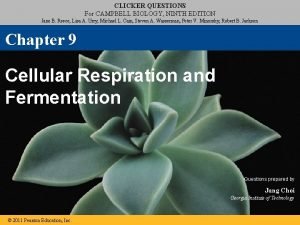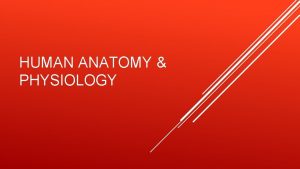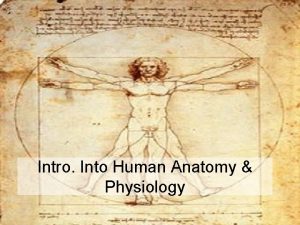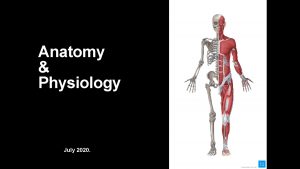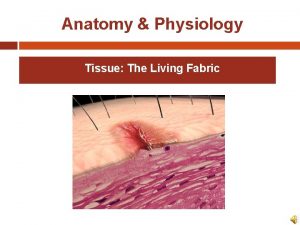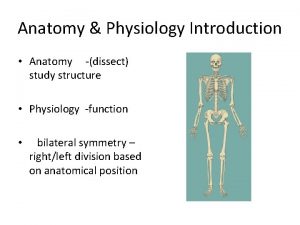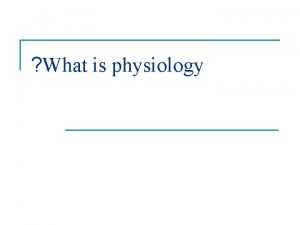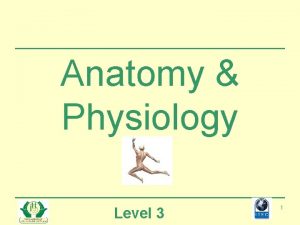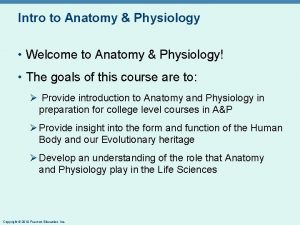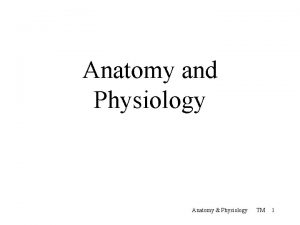Human Anatomy Physiology Ninth Edition CHAPTER 21 19








































- Slides: 40

Human Anatomy & Physiology Ninth Edition CHAPTER 21 19 21 The. Immune System: Innateand and. Adaptive: Body. Defenses

Immunity • What is it? • Resistance to disease • Immune system has two intrinsic systems • Innate (nonspecific) defense system • Adaptive (specific) defense system

Immunity - Innate Defense System Two lines of defense: • 1 st line of defense is external body membranes • 2 nd line of defense is antimicrobial proteins, phagocytes, and other cells • Inflammation is its most important mechanism

Immunity - Adaptive Defense System • 3 rd line of defense attacks particular foreign substances • Takes longer to react than the innate system

Surface barriers • Skin • Mucous membranes Innate defenses Internal defenses • Phagocytes • NK cells • Inflammation • Antimicrobial proteins • Fever Humoral immunity • B cells Adaptive defenses Cellular immunity • T cells

Innate Defenses • Surface barriers • Skin, mucous membranes, and their secretions • Physical barrier to most microorganisms • Keratin is resistant to weak acids and bases, bacterial enzymes, and toxins • Mucosae provide similar mechanical barriers

Surface Barriers • Protective chemicals inhibit or destroy microorganisms • Skin acidity • Lipids in sebum and dermcidin in sweat • HCl and protein-digesting enzymes of stomach mucosae • Lysozyme of saliva and lacrimal fluid • Mucus

Surface Barriers • Respiratory system modifications • Mucus-coated hairs in the nose • Cilia sweep dust- and bacteria-laden mucus

Internal Defenses: Cells and Chemicals • Necessary if microorganisms invade deeper tissues • Phagocytes • Natural killer (NK) cells • Inflammatory response • Antimicrobial proteins (interferons and complement proteins) • Fever

Phagocytes • Macrophages develop from monocytes to become the chief phagocytic cells • Free macrophages wander through tissue spaces • Ex) alveolar macrophages • Fixed macrophages are permanent residents of some organs • Ex) Kupffer cells (liver) and microglia (brain)

Mechanism of Phagocytosis Step 1: Adherence of phagocyte to pathogen • Facilitated by opsonization • coating of pathogen by complement proteins or antibodies

Innate defenses Internal defenses (a) A macrophage (purple) uses its cytoplasmic extensions to pull spherical bacteria (green) toward it. Scanning electron micrograph (1750 x).

1 Phagocyte adheres to pathogens or debris. Lysosome Phagosome (phagocytic vesicle) Acid hydrolase enzymes (b) Events of phagocytosis. 2 Phagocyte forms pseudopods that eventually engulf the particles forming a phagosome. 3 Lysosome fuses with the phagocytic vesicle, forming a phagolysosome. 4 Lysosomal enzymes digest the particles, leaving a residual body. 5 Exocytosis of the vesicle removes indigestible and residual material.

Mechanism of Phagocytosis • Destruction of pathogens • Acidification and digestion by lysosomal enzymes • Respiratory burst • Release of cell-killing free radicals • Activation of additional enzymes • Oxidizing chemicals (e. g. H 2 O 2) • Defensins (in neutrophils)

Natural Killer (NK) Cells • Large granular lymphocytes • Not phagocytotic • Target cells that lack “self” cell-surface receptors • Non-specific killers • Induce apoptosis in cancer cells and virusinfected cells

Inflammatory Response • Triggered whenever body tissues are injured or infected • Prevents the spread of damaging agents • Disposes of cell debris and pathogens • Sets the stage for repair

Inflammatory Response Cardinal signs of acute inflammation: 1. Redness 2. Heat 3. Swelling 4. Pain And sometimes 5. Impairment of function

Inflammatory Response • Macrophages and epithelial cells of boundary tissues bear Toll-like receptors (TLRs) • TLRs recognize specific classes of infecting microbes • Activated TLRs trigger the release of cytokines that promote inflammation

Innate defenses Internal defenses Inflammatory chemicals diffusing from the inflamed site act as chemotactic agents. Leukocytosis. Neutrophils enter blood from bone marrow. 1 Margination. Neutrophils cling to capillary wall. 2 Chemotaxis. Neutrophils follow chemical trail. 4 Capillary wall Basement membrane Endothelium Diapedesis. Neutrophils flatten and squeeze out of capillaries. 3

Innate defenses Internal defenses Tissue injury Release of chemical mediators (histamine, complement, kinins, prostaglandins, etc. ) Release of leukocytosisinducing factor Leukocytosis (increased numbers of white blood cells in bloodstream) Initial stimulus Vasodilation of arterioles Increased capillary permeability Local hyperemia (increased blood flow to area) Capillaries leak fluid (exudate formation) Attract neutrophils, monocytes, and lymphocytes to area (chemotaxis) Leukocytes migrate to injured area Margination (leukocytes cling to capillary walls) Physiological response Signs of inflammation Leaked protein-rich fluid in tissue spaces Result Pushes fluid into lymphatic Heat Redness Locally increased temperature increases metabolic rate of cells Pain Swelling Possible temporary limitation of joint movement Leaked clotting proteins form interstitial clots that wall off area to prevent injury to surrounding tissue Temporary fibrin patch forms scaffolding for repair Healing Diapedesis (leukocytes pass through capillary walls) Phagocytosis of pathogens and dead tissue cells (by neutrophils, short-term; by macrophages, long-term) Pus may form Area cleared of debris

Antimicrobial Proteins • Interferons (IFNs) and complement proteins • Attack microorganisms directly • Hinder microorganisms’ ability to reproduce

Innate defenses Virus Viral nucleic acid 1 Virus Internal defenses New viruses enters cell. 5 Antiviral proteins block viral reproduction. 2 Interferon genes switch on. DNA Nucleus m. RNA 4 Interferon 3 Cell produces interferon molecules. Host cell 1 Infected by virus; makes interferon; is killed by virus Interferon Host cell 2 Binds interferon from cell 1; interferon induces synthesis of protective proteins binding stimulates cell to turn on genes for antiviral proteins.

Interferons • Functions • Anti-viral • Reduce inflammation • Activate macrophages and mobilize NK cells • Genetically engineered IFNs for • Antiviral agents against hepatitis and genital warts virus • Multiple sclerosis treatment

Complement • ~20 blood proteins that circulate in an inactive form • Include C 1–C 9, factors B, D, and P, and regulatory proteins • Major mechanism for destroying foreign substances

Complement • Amplifies all aspects of the inflammatory response • Kills bacteria and certain other cell types by cell lysis • Enhances both nonspecific and specific defenses

Classical pathway Antigen-antibody complex + complex Opsonization: coats pathogen surfaces, which enhances phagocytosis Insertion of MAC and cell lysis (holes in target cell’s membrane) Alternative pathway Spontaneous activation + Stabilizing factors (B, D, and P) + No inhibitors on pathogen surface Enhances inflammation: stimulates histamine release, increases blood vessel permeability, attracts phagocytes by chemotaxis, etc. Pore Complement proteins (C 5 b–C 9) Membrane of target cell

Fever • Systemic response to invading microorganisms • Leukocytes and macrophages exposed to foreign substances secrete pyrogens • Pyrogens reset the body’s thermostat upward

Adaptive Defenses • The adaptive immune system • Protects against infectious agents and abnormal body cells • Amplifies the inflammatory response • Activates complement

Adaptive Defenses Adaptive immune response • Is specific • Is systemic • Has memory Two separate overlapping arms 1. Humoral (antibody-mediated) immunity 2. Cellular (cell-mediated) immunity

Antigens • Substances that can mobilize the adaptive defenses and provoke an immune response • Most are large, complex molecules not normally found in the body (nonself)

Self-Antigens • Protein molecules (self-antigens) on the surface of cells • Antigenic to others in transfusions or grafts • Ex: MHC proteins • Coded for by genes of the major histocompatibility complex (MHC) and are unique to an individual

MHC Proteins • Classes of MHC proteins • Class I MHC proteins, found on virtually all body cells • Class II MHC proteins, found on certain cells in the immune response

Immunological Memory • Primary immune response • Occurs on the first exposure to a specific antigen • Lag period: three to six days • Peak levels of plasma antibody are reached in 10 days • Antibody levels then decline

Immunological Memory • Secondary immune response • Occurs on re-exposure to the same antigen • Sensitized memory cells respond within hours • Antibody levels peak in two to three days at much higher levels • Antibodies bind with greater affinity • Antibody level can remain high for weeks to months

Adaptive defenses Humoral immunity Primary response (initial encounter with antigen) Activated B cells Proliferation to form a clone Plasma cells (effector B cells) Memory B cell— primed to respond to same antigen Secreted antibody molecules Secondary response (can be years later) Antigen binding to a receptor on a specific B lymphocyte (B lymphocytes with non-complementary receptors remain inactive) Clone of cells identical to ancestral cells Subsequent challenge by same antigen results in more rapid response Plasma cells Secreted antibody molecules Memory B cells

Secondary immune response to antigen A is faster and larger; primary immune response to antigen B is similar to that for antigen A. Primary immune response to antigen A occurs after a delay. Antibodies to B Antibodies to A First exposure to antigen A Second exposure to antigen A; first exposure to antigen B Time (days)

Classes of Antibodies • Ig. M • A pentamer; first antibody released • Potent agglutinating agent • Readily fixes and activates complement • Ig. A (secretory Ig. A) • Monomer or dimer; in mucus and other secretions • Helps prevent entry of pathogens

Classes of Antibodies • Ig. D • Monomer attached to the surface of B cells • Functions as a B cell receptor • Ig. G • Monomer; 75– 85% of antibodies in plasma • From secondary and late primary responses • Crosses the placental barrier

Classes of Antibodies • Ig. E • Monomer active in some allergies and parasitic infections • Causes mast cells and basophils to release histamine

Adaptive defenses Humoral immunity Antigen-antibody complex Antibody Inactivates by Neutralization (masks dangerous parts of bacterial exotoxins; viruses) Agglutination (cell-bound antigens) Enhances Phagocytosis Fixes and activates Precipitation (soluble antigens) Enhances Complement Leads to Inflammation Chemotaxis Histamine release Cell lysis
 Anatomy and physiology ninth edition
Anatomy and physiology ninth edition Human anatomy and physiology seventh edition marieb
Human anatomy and physiology seventh edition marieb Uterus perimetrium
Uterus perimetrium Waistline
Waistline Chapter 1 introduction to human anatomy and physiology
Chapter 1 introduction to human anatomy and physiology Chapter 2 human reproductive anatomy and physiology
Chapter 2 human reproductive anatomy and physiology Levels of analysis psychology
Levels of analysis psychology Macroeconomics mankiw 9th edition
Macroeconomics mankiw 9th edition General adaptation syndrome
General adaptation syndrome Social psychology ninth edition
Social psychology ninth edition Biology ninth edition
Biology ninth edition Laura e berk child development (9th edition pdf)
Laura e berk child development (9th edition pdf) Child development ninth edition
Child development ninth edition Abnormal psychology ronald j comer 9th edition
Abnormal psychology ronald j comer 9th edition Psychology ninth edition in modules
Psychology ninth edition in modules Psychology ninth edition in modules
Psychology ninth edition in modules Biology ninth edition
Biology ninth edition Campbell ninth edition
Campbell ninth edition Holes essential of human anatomy and physiology
Holes essential of human anatomy and physiology The central sulcus divides which two lobes? (figure 14-13)
The central sulcus divides which two lobes? (figure 14-13) Anatomy and physiology chapter 8 special senses
Anatomy and physiology chapter 8 special senses Chapter 13 anatomy and physiology of pregnancy
Chapter 13 anatomy and physiology of pregnancy Chapter 2 basic chemistry anatomy and physiology
Chapter 2 basic chemistry anatomy and physiology Chapter 7:9 lymphatic system
Chapter 7:9 lymphatic system Anatomy and physiology coloring workbook figure 14-1
Anatomy and physiology coloring workbook figure 14-1 Chapter 10 blood anatomy and physiology
Chapter 10 blood anatomy and physiology Anatomy and physiology chapter 15
Anatomy and physiology chapter 15 Anatomy and physiology chapter 1
Anatomy and physiology chapter 1 Holes anatomy and physiology chapter 1
Holes anatomy and physiology chapter 1 Gi tract histology
Gi tract histology Anatomy and physiology chapter 8 skeletal system
Anatomy and physiology chapter 8 skeletal system Chapter 6 general anatomy and physiology
Chapter 6 general anatomy and physiology 2012 pearson education inc anatomy and physiology
2012 pearson education inc anatomy and physiology Human anatomy fifth edition
Human anatomy fifth edition Human anatomy fifth edition
Human anatomy fifth edition Physiology of sport and exercise 5th edition
Physiology of sport and exercise 5th edition Upper respiratory tract labeled
Upper respiratory tract labeled Tattoo anatomy and physiology
Tattoo anatomy and physiology International anatomy olympiad
International anatomy olympiad Specialized stems examples
Specialized stems examples Anatomy and physiology of bone
Anatomy and physiology of bone










